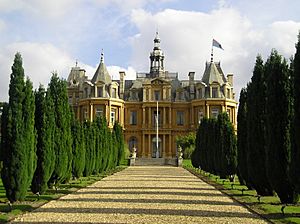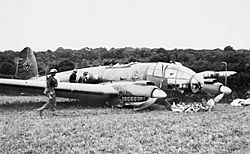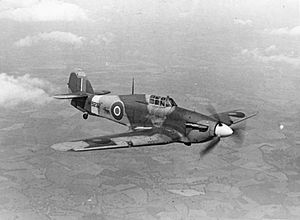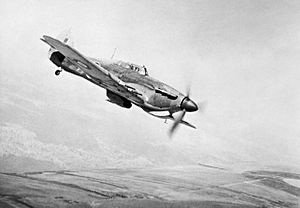Frank Reginald Carey facts for kids
Quick facts for kids
Frank Reginald Carey
|
|
|---|---|
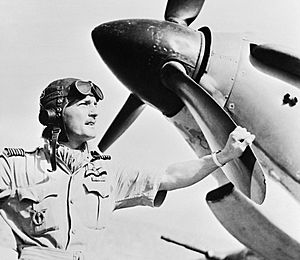
Carey, with his Hurricane, RAF Amarda Road, India in April 1943.
|
|
| Nickname(s) | Chota |
| Born | 7 May 1912 Brixton, England |
| Died | 6 December 2004 (aged 92) Chichester, England |
| Allegiance | United Kingdom |
| Service/ |
Royal Air Force |
| Years of service | 1927–1960 |
| Rank | Group Captain |
| Commands held | RAF Honiley (1952–53) No. 135 Wing (1948–49) No. 73 Operational Training Unit (1944–45) No. 165 Wing (1942–43) No. 135 Squadron (1941–42) |
| Battles/wars | World War II |
| Awards | Commander of the Order of the British Empire Distinguished Flying Cross & Two Bars Air Force Cross Distinguished Flying Medal Silver Star (United States) |
| Other work | Rolls-Royce Aero Engine Division |
Frank Reginald "Chota" Carey (7 May 1912 – 6 December 2004) was a brave Royal Air Force (RAF) fighter pilot and a "flying ace" during World War II. This means he shot down many enemy aircraft.
Born in Brixton, London, Frank joined the RAF in September 1927 when he was just 15 years old. He started as an apprentice metal rigger, learning how to build and fix aircraft. After his training, he became a pilot and flew with No. 43 Squadron RAF.
When World War II began in September 1939, Frank flew patrols over eastern Scotland and achieved his first victories. He was recognized for his bravery and skill, earning several important medals throughout his career. He fought in major battles like the Battle of France and the Battle of Britain, and later in the Pacific War against Japanese forces. Frank Carey was known for his courage and his incredible flying abilities.
Contents
Becoming an RAF Pilot
Frank Reginald Carey was born in Brixton, London, on 7 May 1912. He was the oldest of three brothers. As a child, he was fascinated by planes. He went to Belvedere School, and a former student who became an RAF fighter pilot often flew low over the school, inspiring Frank to dream of becoming a pilot himself.
Frank joined the RAF in September 1927 through a special apprenticeship program at RAF Halton. This program helped young people learn important skills for the air force. He worked hard and was accepted into the RAF as an airframe fitter, which meant he helped build and maintain aircraft.
In 1930, Frank was sent to No. 43 Squadron RAF at RAF Tangmere. He improved his technical skills and, in 1935, was chosen for pilot training. He completed his training in 1936 and rejoined 43 Squadron as a sergeant pilot, flying Hawker Fury planes. Because he was quite short (5 feet 3 inches), his friends in the RAF nicknamed him "Chota," which means "little one."
Frank flew different types of planes and took part in air displays. By 1939, he had spent many hours flying, preparing for what would become a global conflict.
World War II Begins
On 1 September 1939, Germany invaded Poland, starting World War II. Britain declared war on 3 September. Frank's squadron, 43 Squadron, moved to RAF Acklington in northern England to defend the area. The winter of 1939–1940 was very cold, but there wasn't much enemy activity at first.
First Victories in the Air
In January 1940, Frank and his squadron began to encounter German bombers. On 30 January, Frank and another pilot, Caesar Hull, intercepted 26 German Heinkel He 111 bombers that were attacking ships. They managed to shoot down one of the bombers, which crashed into the sea.
On 3 February, Frank and his wingman, Sergeant Peter Ottewill, shot down another Heinkel He 111. This bomber crashed into the sea, and its pilot was captured. For these actions, Frank was awarded the Distinguished Flying Medal (DFM) on 21 February 1940. This was a very important award for his bravery.
On 1 April 1940, Frank was promoted to pilot officer. He was then transferred to No. 3 Squadron RAF.
Fighting in France
On 10 May 1940, Germany invaded France, Belgium, and the Netherlands. Frank's squadron was immediately sent to Merville, Nord in France. They quickly found themselves in intense air battles.
On their first day, 10 May, Frank's squadron engaged German Heinkel He 111 bombers. Frank was officially credited with shooting down two enemy planes by himself, his first solo victories. The fighting was tough, and the radios in their planes often didn't work, meaning pilots had to fight independently.
On 11 May, Frank shot down another Heinkel He 111. The next day, 12 May, he flew four missions supporting French and Belgian forces. On 13 May, Frank had an incredible day, claiming six enemy aircraft, which made him an "ace in a day". He shot down two Junkers Ju 87 Stukas (dive bombers) and a Dornier Do 17. Later, he claimed a Heinkel He 111 and a Henschel Hs 123 biplane.
On 14 May, Frank flew his last mission in the French campaign. He shot down a Dornier Do 17, but his own Hurricane was hit by enemy fire and caught fire. He was wounded in the knee. Frank decided to crash-land his burning plane in a field. He was picked up by Belgian soldiers, and the German crew he had shot down were also captured nearby.
Frank was eventually taken to a recovery unit in southern France. As the Allied forces were collapsing, he and other airmen found a working transport plane and flew back to England on 7 June. He discovered he had been reported missing in action.
The Battle of Britain
Frank was awarded the Distinguished Flying Cross (DFC) and a "Bar" (meaning a second DFC) for his actions in France. These awards were announced on 31 May 1940. After a week of leave, he rejoined 43 Squadron on 24 June 1940, just as the Battle of Britain was about to begin.
The Battle of Britain was a huge air campaign where the German air force (the Luftwaffe) tried to destroy the RAF to prepare for an invasion of Britain.
On 9 July, Frank's squadron intercepted German Messerschmitt Bf 110 heavy fighters. Frank claimed one Bf 110 damaged. On 19 July, he was in action again, claiming one Messerschmitt Bf 109 shot down and two damaged. This battle was costly for his squadron, with two Hurricanes lost and pilots injured or killed.
On 8 August, the Luftwaffe launched a massive attack on a British convoy. Frank's squadron was scrambled to defend it. Frank's Hurricane was damaged by cannon fire from a Bf 110, which blew a large hole in his wing. He was also hit by a Bf 110 that shot off his rudder and an elevator. Despite the damage, Frank managed to fly his crippled plane back to Tangmere. He described the raid as "terrible" and "inextricable," like "trying to stop a Steamroller".
On 12 August, the Luftwaffe attacked the naval base at Portsmouth. Frank likely shot down a Junkers Ju 88 bomber. The next day, 13 August, known as "Eagle Day," the Germans began a concentrated effort to destroy airbases. Frank was in action all day, claiming one Ju 88 destroyed and two damaged.
On 16 August, Frank's squadron intercepted Ju 87 Stukas and Bf 110s heading to attack their home airfield at Tangmere. The airfield suffered heavy damage. Frank claimed two Ju 87s destroyed and two probably destroyed.
On 18 August 1940, known as "The Hardest Day" due to the intensity of the fighting, Frank flew his last mission in the battle. He shot down a Ju 87, but was hit in the knee by a bullet. He couldn't land at Tangmere and had to crash-land his Hurricane at Pulborough. Frank was the only pilot from his squadron injured that day.
After recovering from his wounds, Frank returned to 43 Squadron. However, the squadron had suffered many losses. On 7 September, the Luftwaffe began its first deliberate attack on London, starting "The Blitz". Morale was low, and the squadron was sent north to rest. Frank was promoted to Flight Commander and continued to fly patrols until the Battle of Britain ended in October 1940.
Service in the Far East
In February 1941, Frank left 43 Squadron to become an instructor at a training unit. He taught other pilots how to fly and fight. On 25 August, he was given command of a new squadron, No. 135 Squadron RAF.
Originally, 135 Squadron was supposed to go to the Middle East, but in December, they were sent to Burma (now Myanmar) to fight against the Japanese invasion. Frank and his squadron arrived in Rangoon on 19 January 1942, in the middle of an air raid.
The Japanese forces were very successful in their early attacks in Southeast Asia. Frank's squadron faced many challenges, including few aircraft and spare parts. On 29 January, Frank's squadron had its first combat with the Japanese. Frank shot down a Nakajima Ki-27 fighter.
On 6 February 1942, Frank was promoted to acting wing commander. He led many missions, including bomber escorts and ground-attack missions. On 23 February, he shot down a Mitsubishi Ki-51 reconnaissance plane. The next day, he attacked a Japanese airfield and claimed a Ki-27 and an unidentified transport plane shot down.
Frank's last victory for several months was on 26 February 1942, when he shot down a Nakajima Ki-43 fighter. During this fight, his wingman saved him by shooting down a Japanese plane that was attacking Frank.
As the Japanese advanced, the RAF units in Burma had to retreat. Frank was ordered to fly to Calcutta to get supplies and reinforcements. He managed to get back to India, where he learned that his base had been bombed and all the Hurricanes were lost. He received a second Bar to his DFC on 24 March 1942. For the rest of 1942, Frank and his wing stayed in India, defending against Japanese air attacks.
In July, the squadron received new Hurricane IICs, which had powerful cannons. On 12 October 1942, Frank was promoted to officer commanding 165 Wing RAF. On 25 October, he shot down a Ki-43 in a rare air combat. The next day, while refueling, he bravely took off when 27 Japanese Ki-43s attacked. He managed to avoid being hit and landed safely.
End of Combat Operations
In January 1943, Frank was relieved of his combat command. The following month, he was appointed head of the Air Fighting Training Unit at RAF Amarda Road in India. Here, he was responsible for training all RAF pilots in Southeast Asia on air combat tactics.
Frank returned to Britain for leave in June 1943. He trained on newer aircraft like the Supermarine Spitfire and P-51 Mustang. When he returned to India, he used this knowledge to train pilots for these advanced planes. In April 1944, he also trained United States Army Air Force pilots on tactics for fighting Japanese air and ground targets.
On 2 November 1944, Frank was posted to command a training unit in Egypt as a Group Captain. He mostly flew Spitfires and P-47s to prepare pilots for the Italian campaign. On 1 January 1945, he was awarded the Air Force Cross for his excellent leadership in India and Burma.
On 10 June 1945, Frank was appointed to RAF Tangmere as the officer commanding tactics for the Central Fighter Establishment. He took part in a flypast in September 1945 to celebrate the fifth anniversary of the Battle of Britain and the end of the war.
After the War
After World War II, Frank Carey continued his career in the RAF. He was given a permanent commission as a squadron leader in September 1945 and was promoted to wing commander in May 1946. He held various important positions, including training officer in Germany and wing commander in Scotland.
In October 1952, he became station commander at RAF Honiley in England. In April 1953, he was promoted to group captain and assigned to Fighter Command headquarters in January 1956.
From November 1957 to June 1960, Frank served as an air adviser to the British High Commission in Australia. He retired from the RAF in June 1960 and began working for the Rolls-Royce Aero Engine Division in Australia. On 11 June 1960, he was appointed a Commander of the Order of the British Empire, a high honor.
After retiring from Rolls-Royce, Frank returned to England in September 1973. He passed away in Chichester at the age of 92.
Air Combat Victories
Frank Carey was a highly successful fighter pilot. He was officially credited with shooting down 23 enemy aircraft, sharing in the destruction of six others, and damaging ten. Of his 23 solo victories, 15 were German planes and 8 were Japanese planes.


